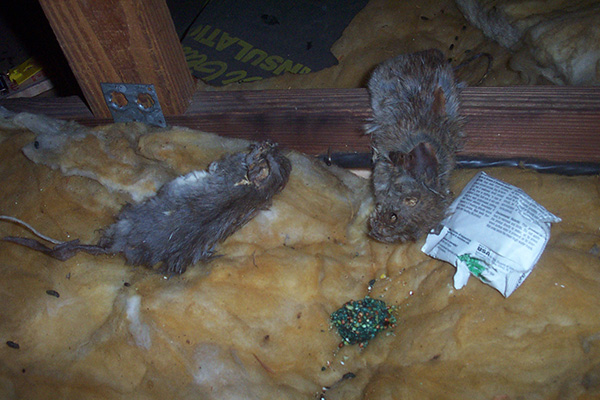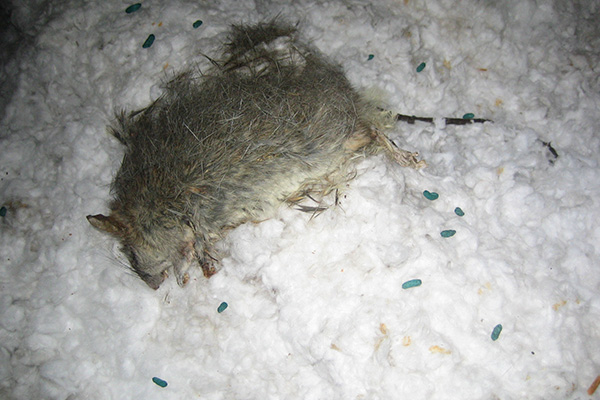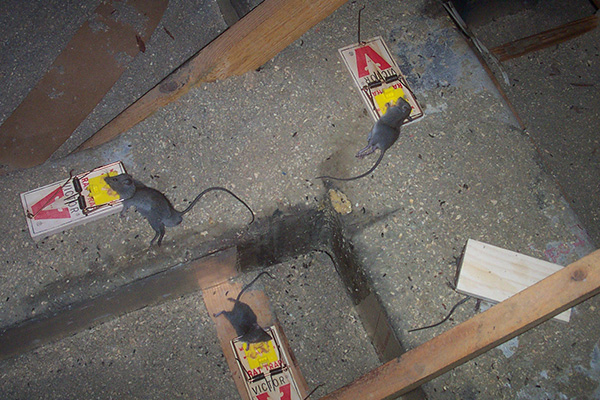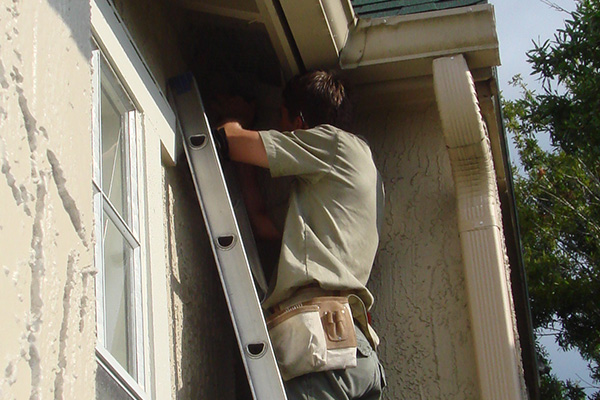- info@animalatticpest.com
- Call - we service 300 locations

How to Kill Mice in the Attic - Does Poison Work?
Okay - If I hope to accomplish just one thing with this website, it is this: to educate the public about how lousy mouse poison is! It is a bad approach to mouse control on every level. It is costly over time. It is a trick pest control
companies use to keep you paying them forever. It is inhumane. It is potentially dangerous to other animals or you. It results in stinking dead mice odors. But most of all, it is INEFFECTIVE! Rodenticides cause mice to die of internal
bleeding and hemmoraging when they eat it. Inhumane, but you may not care. What you should care about is that poison is slow, inefficient, and never solves the problem permanently. First of all, not all the mice will find and eat the poison.
They mostly eat food outside, and they are scattered in your attic and house, and most of them never come across the poison. Second of all, not every mouse who eats the poison will die. So you're left with living mice, which reproduce so
fast, that you have the same number of mice you always had, prior to the poison. Third of all, the ones that did die will die in the attic and walls and cause a terrible odor problem. Read about dead mice in the attic
if you've set out poison. Fourth, though it's unlikely because you are careful, it's possible you could get sick from poison contact, or another animal might accidentally eat it. But fifth and most importantly, the problem never gets solved! This is
what the pest control companies want - they want to sign you up for a monthly or quarterly poisoning contract for life, and to keep getting paid forever - if they solve the problem, the money train stops.
Here is what you want to do - solve the problem PERMANENTLY with the only effective way to do so - you must find out how the mice are getting inside your house and attic, and you must seal shut all of these entry holes and gaps with non-chewable
steel screen. If you successfully do that, the problem is solved forever! When I do a mouse job, it takes just 3 days for me to stop the problem permanently. The pest control company wants three decades of your time and money! And don't forget,
the longer mice are up there, the more mouse damage they cause. So do it right - seal the entry holes shut. After you have done so, trapping the mice on snap traps is super easy. Read about the correct
mouse trapping method, and voila, the problem is solved. The pest control and rodent poison industry wants you to use their product. Don't.
Is Killing Mice the Best Approach to Solve the Problem?
Poison Results in Stinky Dead Mice!
This is just one of the reasons I don't recommend the use of poison - it kills mice in the attic, and then you have to deal with the terrible odor!
Look at the Blue Feces
A customer called me to find the source of the terrible smell. Look at the blue feces around this mouse carcass. That's from the blue die in the poison.
Trapping Them Ensures Removal
Now here's the right way to kill mice - trapping them with snap traps. It's a lot more effective than poison, and as a bonus, you can remove the dead mice to prevent odor.
Information About Killing Mice in the Attic
How To Kill Mice In The Attic – Does Poison Work?
With most wildlife that you will find in your attic, you want to get them out without killing them. While this works well for most animals, mice and rats are an exception. Unfortunately, these are creatures of habit so if you trap and then relocate them to an area outside the territory they are used to, they will face almost certain death. They won’t have shelter to hide from predators in the area and won’t know where to find food and water. They may also face aggression from rodents already living in the area they are moved to. Because the mice would face death if they were relocated, most experts agree that it is more humane to just kill them right away when removing them from your attic. This way, you minimize their suffering. The only question remains how to kill mice in the attic.
Why Poison Is A Bad Idea
Even if poison is the first thing that comes to mind when you want to learn how to kill mice in the attic, poison does not work. The first issue is that it is not always effective since the mice will have to ingest it, which you can’t guarantee. If you kill some mice with poison, new ones will just appear to take their place. Not only is poison ineffective, however, but it is also inhumane and makes more work for you. Poison won’t kill the mouse instantly, instead leaving it to die slowly and in pain. While poison may seem like a quick fix on your part, particularly if you don’t care whether the mouse suffers, take some time to think it through. The mice won’t die right where you leave the poison. Instead, they will make their way somewhere they feel comfortable to die, such as a nook hidden in the wall or a nest behind insulation. This leaves you with rotting mouse carcasses you have to find and remove, along with a horrible smell.
Glue Traps Are Also Ineffective
Since you know that poison doesn’t work to kill mice in the attic, you may be wondering about glue traps. Unfortunately, these are also ineffective and inhumane. Glue traps theoretically work by getting the mice stuck to them. The animals would then die slowly of starvation, dehydration, or exposure, none of which would be humane. Even if you were willing to go around to the glue traps and put the mice out of their misery when they are caught, there would be other issues. Glue traps aren’t reusable so you have to keep buying them, making them an expensive solution depending on the number of mice in the attic. To make matters worse, glue traps aren’t always effective. Mice will sometimes be caught by a part of their body and do whatever it takes to escape. This may mean tearing off fur or even gnawing off a limb. In addition to being inhumane to force a mouse into this situation, it also means that you will have a mouse that may die of blood loss somewhere in your attic, leaving you with the issue of a decaying carcass.
Use Snap Traps Instead
With both of those options out of bounds, snap traps become the clear winner for killing mice in your attic. Snap traps are reusable so you will only have to buy them once and can take on as many infestations as you come across or keep resetting them to catch stragglers. They are also easy to use and will kill the mice instantly, making them a humane option. All of these reasons are why wildlife removal experts strongly prefer snap traps and you should never hire one that chooses a different method.
What To Do Before Setting Up Snap Traps
Of course, any method of killing mice in the attic will be useless unless you take steps to prevent more mice from coming inside. Otherwise, you will just end up in an endless cycle of killing mice and more entering. To prevent this, take the time to seal up every potential entry point into your attic that the mice may use. Even the smallest gaps by vents or windows or in siding should be sealed. This way, no more mice will be able to get inside your attic and you can make sure you kill all of them, getting rid of your problem.
Prevent A Repeat Problem
In addition to sealing up entry points to your home as a way to prevent a repeat issue with mice and having to kill more, you can also make your home less attractive. If the mice found a food source in the attic, remove it so more won’t be attracted. Do the same to food sources in other areas of your home, such as leftovers that sit out in your kitchen counter or food-filled garbage.
The Bottom Line
How to kill mice in the attic - no matter how much you may hate mice, it's a heck of a lot easier and more effective to just do a proper mouse exclusion. You have the added benefit of not having to deal with mouse carcasses or rotting mouse odor in your house.




